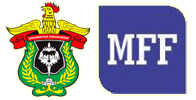SINTESIS NANOPARTIKEL PERAK DENGAN AIR REBUSAN DAUN PEGAGAN (Centella asiatica L.) DAN UJI AKTIVITAS DALAM MENGHAMBAT PERTUMBUHAN BAKTERI Pseudomonas aeruginosa DAN Staphylococcus aureus
Keywords:
Nanopartikel Perak, , Biosintesis, Daun Pegagan, Aktivitas Antibakteri, Nanopartikel Perak, Biosintesis, Daun Pegagan, Aktivitas Antibakteri.Abstract
Daun pegagan (Centella asiatica L.) mengandung bahan aktif seperti saponin, tanin, flavonoid, steroid serta triterpenoid yang dapat mereduksi ion perak. Penelitian ini bertujuan untuk mengetahui apakah air rebusan daun pegagan dapat digunakan sebagai bioreduktor dalam mensintesis nanopartikel perak serta untuk mengetahui apakah hasil biosintesis daun pegagan memiliki aktivitas daya hambat terhadap bakteri Pseudomonas aeruginosa dan Staphylococcus aureus. Penelitian ini merupakan penelitian eksperimental. Penentuan aktivitas daya hambat terhadap bakteri Pseudomonas aeruginosa dan Staphylococcus aureus dengan metode difusi cakram. Hasil penelitian menunjukan air rebusan daun pegagan segar dapat digunakan sebagai bioreduktor dalam mensintesis nanopartikel perak yang ditandai dengan adanya puncak serapan pada panjang gelombang 400-500 nm. Ukuran nanopartikel perak yang dihasilkan berkisar 50 s/d 90 nm. Aktivitas antibakteri dari hasil biosintesis memiliki rata-rata zona hambat 25 mm (sangat kuat) untuk bakteri Pseudomonas aeruginosa dan 22,6 mm (sangat kuat) untuk Staphylococcus aureus. Disimpulkan bahwa daun pegagan dapat mereduksi dan memiliki aktivitas antibakteri terhadap Pseudomonas aeruginosa dan Staphylococcus aureus.
References
Kasim Syahruddin et al. Sintesis Nanopartikel Perak Menggunakan Ekstrak Daun Enceng Gondok (Eichornia crassipes) Sebagai Bioreduktor. KOVALEN: Jurnal Riset Kimia, 6(2). 2020: halaman 126-133. DOI : https://doi.org/10.22487/kovalen.2020.v6.i2.15137
Prasetyaningtyas Tiwi. Sintesis Nanopartikel Perak Termodifikasi Kitosan dengan Bioreduktor Ekstrak Daun Kemangi (Ocimum basilicum L.) dan Uji Aktivitasnya sebagai Antibakteri. Indonesian Journal of Chemical Science.p-ISSN 2252-695, e-ISSN 2502-6844: 2020
Dewi Sari T. Komang et al. Karakter Fisik dan Aktivitas Antibakteri Nanopartikel Perak Hasil Green Synthesis Menggunakan Ekstrak Air Daun Sendok (Plantago Major L.).Pharmaceutical Sciences and Research (PSR), 6(2). E-ISSN 2477-0612 : 2019
Handayani Windri. Pemanfaatan Tumbuhan Tropis Untuk Biosintesis Nanopartikel Perak Dan Aplikasinya Sebagai Indikator Kolorimetri Keberadaan Logam Berat. Tesis. FMIPA UI Jakarta : 2011
Yunita Ella dan Sari Puspita Ayu Ratna Dyah. Potensi Antibakteri Pegagan (Centella asiatica) Terhadap Bakteri Gram. Jurnal Emasains: Jurnal Edukasi Matematika dan Sains : 2011 P-ISSN 2302-2124. DOI : 10.5281/zenodo.4305182
Alyidrus Rugayyah., Jumardin Wahyudin dan Farid Nurfiddin. 2018. Panduan Praktikum Farmakognosi I. Universitas Megarezky : Makassar.
Matutu, J. M., Maming, & Taba, P. Sintesis Nanopartikel Perak Dengan Metode Reduksi Menggunakan Buah Merah (Pandanus conoideus) Sebagai Bioreduktor. (diunduh di https://pdfs.semanticscholar.org/76f8/fb46e35a6b1c311b35140f39d39a3ab7509a.pdf pada tanggal 14 Februari 2022).2016
Masakke, Y., Rasyid, M., & Sulfikar. Biosintesis Partikel-nano Perak Menggunakan Ekstrak Metanol Daun Manggis (Garcinia mangostana L.). Jurnal Sainsmat. 2015: 4(1): 28–41.
Taba, P., Paramitha, N., & Kasim, S. Sintesis Nanopartikel Perak Menggunakan Ekstrak Daun Salam (Syzygium polyanthum) Sebagai Bioreduktor Dan Uji Aktivitasnya Sebagai Antioksidan. Indo. J. Chem. Res., 7(1): 51–60. 2019
Haryani Yuli et al. Pemanfaatan Ekstrak Air Rimpang Jahe Merah (Zingiber officinale Linn. var. rubrum) Pada Biosintesis Sederhana Nanopartikel Perak. Chimica et Natura Acta Vol. 4, No. 3. 2016
Purnomo Ribka Septiana et al..Studi Sintesis Nanopartikel Perak Dengan Metode biologi Menggunakan Tanaman Sambiloto (Andrographis paniculata Ness). Buletin Fisika Vol. 18, No.1. 2017
Fitriyanti La Tapa,Edi S,Lidya I. Biosintesis Nanopartikel Perak Menggunakan Ekstrak Empelur Batang Sagu Baruk (Arenga microcarpha) dan aktivitas antioksidannya. Chem.Prog.Vol.9 (1):2016
Ahmad, M., M.Y. Tay, K. Shameli, M.Z. Hussein, & J.J. Lim. 2011. Green Synthesis and Characterization of Silver/Chitosan/Polyethylene Glycol Nanocomposites without any Reducing Agent. Int. J. Mol. Sci, 12 (2): 4872-4884
Fatihin Saiful. Sintesis Nanopartikel Perak Menggunakan Bioreduktor Ekstrak Aquades Buah Jambu Biji Merah (Psidium guajava L.) Dan Iradiasi Microwave. FMIPA Universitas Negeri Malang. 2016
Dewi Asiska permata. Uji Aktivitas Antibakteri Ekstrak Daun Senduduk (Melastoma Affine D.Don) Terhadap Staphylococcus aureus.JOPS (Journal of Pharmacy and science) Vol.3 No.1. 2019
Handayani W. Pemanfaatan Tumbuhan Tropis Untuk Nanopartikel Perak dan Aplikasinya sebagai indicator Kolorimetri Keberadaan ogam Berat. FMIPA.UI 2011
Rohaeti Eli. 2019. Kimia Makromolekul : Tekstil Antibakteri. UNY Press : Yogyakarta.
Susanto, D., Sudrajat dan R. Ruga. 2012. Studi Kandungan Bahan Aktif Tumbuhan Meranti Merah (Shorea leprosula Miq) Sebagai Sumber Senyawa Antibakteri. Mulawarmnan Scientifie. 11 (2): 181-190.
Zakir, M., Maming, Lembang, Y.E., Lembang, S.M. 2014. Synthesis of Silver and Gold Nanoparticles Through Reduction of Ketapang (Terminalia Catappa). Presents in the International Conference on Advanced Material and Partical Nanotechnology: 1-9
Downloads
Published
Issue
Section
License
Copyright (c) 2022 Majalah Farmasi dan Farmakologi

This work is licensed under a Creative Commons Attribution-NonCommercial 4.0 International License.
The copyright to this article is transferred to Universitas Hasanuddin (UNHAS) if and when the article is accepted for publication. The undersigned hereby transfers all rights in and to the paper including without limitation all copyrights to UNHAS. The undersigned hereby represents and warrants that the paper is original and that he/she is the author of the paper, except for material that is clearly identified as to its original source, with permission notices from the copyright owners where required. The undersigned represents that he/she has the power and authority to make and execute this assignment.
We declare that:
- This paper has not been published in the same form elsewhere.
- It will not be submitted anywhere else for publication prior to acceptance/rejection by this Journal.
- A copyright permission is obtained for materials published elsewhere and which require this permission for reproduction.
Furthermore, I/We hereby transfer the unlimited rights of publication of the above-mentioned paper in whole to UNHAS The copyright transfer covers the exclusive right to reproduce and distribute the article, including reprints, translations, photographic reproductions, microform, electronic form (offline, online) or any other reproductions of similar nature.
The corresponding author signs for and accepts responsibility for releasing this material on behalf of any and all co-authors. This agreement is to be signed by at least one of the authors who have obtained the assent of the co-author(s) where applicable. After submission of this agreement signed by the corresponding author, changes of authorship or in the order of the authors listed will not be accepted.


